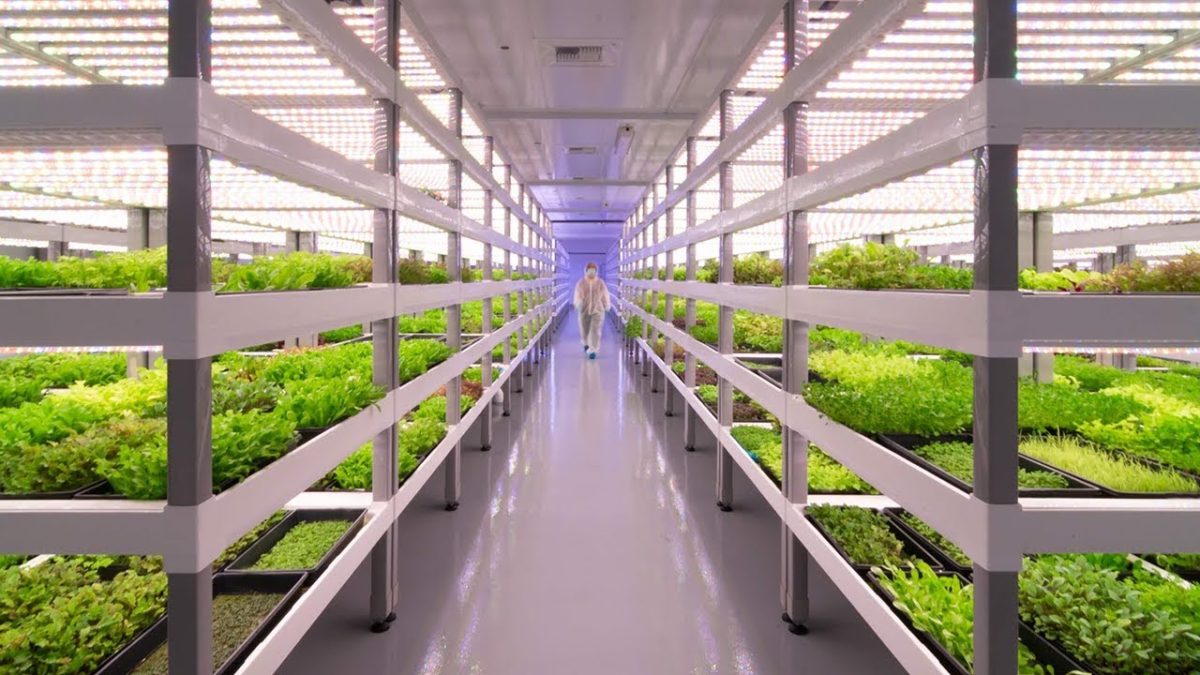Vertical farming is one of the hot topics at the moment. This is also shown by large investments into vertical farms, such as AeroFarms, based in the U.S. which raised another whopping $100m from investors, valuing the company at $500m (FinancialTimes, 2019). However, also in Europe companies like InFarm (valued at $134) and Jones Food Company (just got bought by Ocado) are starting to take off (AgFunder Network Partners, 2019). But why are investors willing to spend so much money on this new technology-driven agriculture and how exactly does vertical farming work?
The idea behind vertical farming is to maximize the yield and to reduce the amount of resources. This is done by cultivating crops and plants in a carefully controlled environment, using artificial intelligence and data analysis to optimize the use of resources. The plants are stacked vertically in large warehouse facilities, where everything from the lighting, water, nutrition, and humidity is controlled and managed by software (thebalancesmb, 2019).
The sustainable approach of vertical farming has many advantages. As these farms can be located close to urban areas, long transportation is being cut short and CO2 emissions are reduced. Moreover, the use of pesticides is highly decreased, because of the controlled indoor environment. The same holds for fertilizers since the crops are not cultivated on soil but on aeroponic, aquaponic or non-soil mediums. As already mentioned above, vertical farming can reduce the amount of water being used. Thanks to data analysis and artificial intelligence, each plant receives only as much water as needed. This is combined with water being recycled, resulting in 95% less water consumption compared to normal outdoor farming (thebalancesmb, 2019). Therefore, it is no surprise that many investors see this as the future of agriculture. Especially, with regards to the ever-increasing population on earth and global warming, providing enough food will be a challenging task and vertical farming surely can help to solve those problems.
However, vertical farming does not come without a downside. It is enormous energy-consuming. Vertical farming uses artificial lighting, usually LED’s which are very energy-intensive. Even though there have been some great improvements for LED efficiency, it is unlikely that this will continue in the near future (Eater, 2018). Of course, with renewable energy this problem could be easily solved, nonetheless, it is not common practice today. As in my introduction already explained, vertical farming is extremely capital dependent. To set up the infrastructure and the optimized indoor environment, large investments are needed. These costs are being passed on the end-consumer, making plants and crops relatively more expensive than ‘traditional’ food. AeroFarm for example only started generating small profits in its 8 year into its nine-year life (Forbes, 2019). This shows that profitability is a bis issue for vertical farms and their dependency on investors and fresh capital. Another aspect which needs to be considered is the variability of crops and plants being cultivated (Forbes, 2019). The easiest plants to be grown artificially are Lettuce, Kale, Basil, and Chives and Mind (A Medium Corporation, 2018). The food industry is following the economic principle of supply and demand. Therefore, if a couple of vertical farms closely located to each other produce more or less the same plants and crops, they are likely to wreck their margins. One very decisive argument is the associated risk with a steady energy supply. In case of an emergency and power failure or outage, vertical farms have very limited options to maintain their operations of cultivating plants.
Even though there are some downsides to vertical farming, it shows great potential to become a supplement to the traditional way of farming. Especially for countries in geographical regions that extremely depend on food imports such the Middle East, vertical farming could give them back a little bit of control of their food supply (Forbes, 2019). Also in the long-run infrastructures and processes will get more efficient and less costly, which will ease the way into the food market and increase their competitiveness. Therefore, it is easy to see why investors would like to get a foot into the door with this aspiring technological advancement for agriculture. However, in my opinion, vertical farming will not be able to substitute the traditional way of agriculture in the short or medium run simply because scaling up the production goes along with enormous capital investments and the not yet sufficient capabilities to produce a greater variety of plants and crops.
References:
Fortado L., & Terazono E. (2019). AeroFarms raises $100m as investors rush to indoor farms, Financial Times [online], available at https://www.ft.com/content/cac48190-9d8a-11e9-9c06-a4640c9feebb [accessed at 15.09.2019]
Holt, S. (2018). Is Vertical farming really the future of Agriculture, Eater, [online] available at https://www.eater.com/2018/7/3/17531192/vertical-farming-agriculture-hydroponic-greens [accessed at 15.09.2019]
Kobayashi-Solomon E. (2019). Investing in vertical farming: 5 take-aways, Forbes [online], available at: https://www.forbes.com/sites/erikkobayashisolomon/2019/04/05/investing-in-vertical-farming-five-take-aways/#e255d9c355c6 [accessed 15.09.2019]
Kobayashi-Solomon E. (2019). Agriculture is broken; AgTech can fix it, The smart money is investing in farm, A medium corporation [online] available at https://medium.com/@Framework_Erik/agriculture-is-broken-agtech-can-fix-it-badf8ade2613 [accessed at 15.09.2019]
Leblanc R. (2019). What you should know about vertical farming, The Balance small business [online] Available at: https://www.thebalancesmb.com/what-you-should-know-about-vertical-farming-4144786 [accessed at 15.09.2019]
Martyn-Hemphill R. (2019). Is UK eGrocer Ocado’s $22m Vertical Farming Investment a Bargain? – Update, AgFunder Network Partners [online] available at https://agfundernews.com/is-ocados-22m-investment-in-vertical-farm-jcb-a-bargain.htm [accessed at 15.09.2019]

